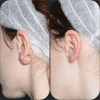Ear keloids: An innovative 3-steps combined treatment
- PMID: 38009040
- PMCID: PMC10605762
- DOI: 10.1111/srt.13506
Ear keloids: An innovative 3-steps combined treatment
Abstract
Introduction: An excessive proliferation of fibroblasts and collagen synthesis after an injury may lead to a benign fibrous tumor, known as keloid, which does not regress spontaneously. Earlobes are a very frequent site of onset, since after a trauma (i.e., piercing) keloids may develop either on the helix and on the anterior or posterior lobe, from a few months up to several years after the injury.
Objectives: To report the effectiveness of a combined protocol of CO2 laser + Dye laser + a portable Blue LED Light medical device for Photobiomodulation Therapy (EmoLED®).
Methods: Fifty-two patients with a total of 56 ear keloids have been treated in the same session with a single CO2 laser procedure + a pulsed Dye laser procedure with an adjunctive EmoLED® procedure for 3 up to 6 min. A monthly follow-up has been performed with an adjunctive EmoLED® session in case of signs of inflammation.
Results: Among 56 treated keloids, 89.3% of them (50/56) did not recur during a follow-up period (from 6 up to 24 months, mean 16.3 months) while six keloids recurred (6/56, 10.7%) with mild thickening of the scar, thus requiring further treatments.
Conclusions: Even if an excellent outcome obtained by the synergistic effect of combined laser treatments has already been described (i.e., CO2 laser + Dye Laser), the present study showed the adjuvant procedure with EmoLED® can reduce significantly the risk of keloids recurrences.
Keywords: EmoLED®; carbon dioxide laser; keloids; pulsed dye laser.
© 2023 The Authors. Skin Research and Technology published by John Wiley & Sons Ltd.
Conflict of interest statement
The authors declare no conflicts of interest.
Figures










References
-
- Brissett AE, Sherris DA. Scar contractures, hypertrophic scars, and keloids. Facial Plast Surg. 2001;17:263‐272 - PubMed
-
- Ogawa R, Miyashita T, Hyakusoku H, Akaishi S, Kuribayashi S, Tateno A. Postoperative radiation protocol for keloids and hypertrophic scars: statistical analysis of 370 sites followed for over 18 months. Ann Plast Surg. 2007;59:688‐691. - PubMed
MeSH terms
LinkOut - more resources
Full Text Sources

